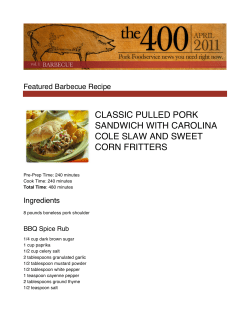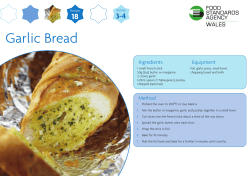
Recipes, Customs and Cuisine of the Dominican Republic April 2014
Recipes, Customs and Cuisine of the Dominican Republic
April 2014
Customs and Cuisine
Dominican Republic cuisine is predominantly made up of a combination of Spanish, indigenous Taíno, and African
influences, the first and last occurring over the last five centuries. Dominican cuisine resembles that of other countries in
Latin America, those of the nearby islands of Puerto Rico and Cuba most of all, though the names of the dishes will
differ.
Breakfast can consist of eggs or meat and mangú (mashed plantain). As in Spain, the largest, most important meal of the
day is lunch. Its most typical form, nicknamed La Bandera ("The Flag"), consists of rice, red beans, meat (beef, chicken,
pork, or fish), and salad.
Since the Dominican Republic was formerly a Spanish colony many Spanish traits are still present on the island. Many
traditional Spanish dishes have found a new home in the Dominican Republic, some with a twist. African and Taíno
dishes still hold strong, some of them unchanged.
All or nearly all food groups are accommodated in typical Dominican cuisine, as it incorporates meat or seafood; grains,
especially rice, corn (native to the island), and wheat; vegetables, such as beans and other legumes, potatoes, yuca, or
plantains, and salad; dairy products, especially milk and cheese; and fruits, such as oranges, bananas, and mangos.
Preferred Dominican beverages include rum, beer, fresh fruit juices, smoothies, and coconut water.
If invited to dinner at a Dominican's home bring a gift such as chocolates or pastries. A handshake, with direct eye
contact and a welcoming smile is standard. Maintaining eye contact is crucial as it indicates interest. Although
punctuality is considered a good thing, guests are not expected to arrive on time for social occasions. Arriving between
15 and 30 minutes later than the stipulated time is considered on time.
Dress well - Dominicans take pride in their appearance and judge others on their clothing. People are extremely fashion
conscious and believe that clothes indicate social standing and success. They take great pride in wearing good fabrics
and clothes of the best standard they can afford. Designer labels, particularly those from the USA, are looked upon
favorably.
Racial and economic issues determine social stratification in the Dominican Republic. People considered “upper class”
are descended from the European settlers and have lighter skin than those considered “lower class” - darker skinned
people descended from African slaves or Haitians. Status is defined more by family background than by absolute wealth.
There is little social mobility.
The family forms the basis of stability. The individual derives a social network and assistance in times of need from the
extended family, which generally encompasses three generations. Often several generations live in the same house.
Loyalty to the family comes before any other social relationship, even business. The Dominican constitution guarantees
freedom of religion. Over 90% of the population is nominally Roman Catholic.
Source: http://www.kwintessential.co.uk/resources/global-etiquette/dominican-republic-country-profile.html
and Mariposa DR Foundation
April 2014
Recipes
Chicharrones de Pollo (Crispy fried chicken)
serves 8
Chicharrones, especially chicken chicharrón (also
known as pica-pollo), are usually eaten with
tostones – see recipe below.
Ingredients:
1 3½ pound chicken, cut into small serving pieces
and rinsed in water and the juice of one sour
orange or lime
1 teaspoon oregano
1 medium red onion, grated
3 garlic cloves, crushed
2 tablespoons rum
2 chicken bouillon cubes, dissolved in 6 tablespoons hot water
6 cups all-purpose flour
vegetable oil for frying
2 limes, cut into wedges
Directions:
At least 6 hours in advance, marinate the chicken pieces with the oregano, onion, garlic, rum and dissolved chicken
bouillon cubes. Refrigerate.
Put at least 2 cups of flour in a large plastic bag. Add a few chicken parts at a time and shake to coat them well and
evenly. Remove the pieces as coated, but don’t shake off the excess. Keep adding flour to the bag until the whole
coating procedure is finished.
Meanwhile, in a big frying pan, heat 2 inches of vegetable oil to medium high temperature. Drop in the chicken parts
and fry them until golden brown on all sides.
Drain, dry on paper towels and serve immediately, garnished with the lime wedges.
Recipe provided by Mariposa DR Foundation
April 2014
Moro de Habichuelas Rojas
(Rice with red beans)
serves 8
Dominicans are not the only ones to serve rice and
beans, or to make moro. This dish seems to exist in
different incarnations in several Caribbean nations.
In Cuba it is referred to as “moros y cristianos” and
Haiti it is known as “ris et pois,” and prepared with
fewer ingredients than the Dominican one.
Ingredients:
1½ cups dry red beans, or 1 16 oz. can of red beans,
drained
2½ cups uncooked white rice
8 cups of water
1 medium red onion, finely chopped
4 garlic cloves, crushed
1 medium green bell pepper, finely chopped
1 teaspoon oregano
1 teaspoon salt
1 tablespoon fresh cilantro, finely chopped
3 tablespoons olive oil
2 chicken bouillon cubes
2 tablespoons tomato paste
½ teaspoon vinegar
Directions:
Soak the beans overnight in enough water to cover. Drain. Place the beans in a large pot and boil them in 8 cups of
water until tender, for about one hour. Add more water if necessary until tenderness is reached. Drain the beans,
reserving the cooking liquid and set the beans aside. Rinse the rice twice in cold water, and drain.
Pour the olive oil into a pan large enough to accommodate the beans and rice, and saute the onion, garlic, green pepper,
oregano, salt, coriander, and the cooked beans (or drained canned beans). Add the chicken bouillon cubes, tomato
paste, vinegar and 1 cup of the bean’s cooking liquid (use 1 cup of water if canned beans were used). Mix well and cook
for three to four minutes, stirring occasionally.
Add 3 ½ more cups of the bean cooking liquid, adding water to complete it, if needed. Bring to a simmer, add the rice
and mix well. Cook uncovered over medium high heat until almost all the liquid has been absorbed. Reduce the heat as
low as possible, cover and simmer for 20 minutes, or until the rice is tender. Remove the lid and allow the Moro style
rice to dry for 5 minutes.
Variation: Substitute 1 cup of unsweetened coconut milk for 1 cup of bean cooking liquid or water.
Recipe Source: Mariposa DR Foundation
April 2014
Tostones (Green Plantain Fritters)
Yield: 20 pieces
Ingredients:
Tostones
3 green plantains
oil for frying (canola or vegetable)
black pepper
salt
garlic powder (optional)
Garlic Dipping Sauce
1/3 cup olive oil
1 teaspoon dried or fresh thyme/cilantro/parsley
black pepper to taste
1/4 teaspoon cayenne pepper
1/4 teaspoon salt
1 tablespooon lime juice
5 cloves garlic, finely minced
Directions:
Heat the oil to medium-high while preparing the plantains. Peel plantains and chop into 1 inch rounds. Fry 1 inch rounds
for 6 minutes, remove from oil. Drain on paper towels.
Smash each piece until flattened. Use a tostonera – see below - or any canned item. Fry for a second time until golden
brown. Sprinkle salt, black pepper, and garlic powder if you are using it, and set aside to cool.
For the garlic dipping sauce, finely chop garlic cloves. In a bowl, add olive oil, thyme, black pepper, cayenne pepper, salt,
lime juice, and garlic. Whisk vigorously and enjoy with hot tostones.
Notes:
Here’s a terrific pictorial on how to make tostones. ( http://www.inner-gourmet.com/2012/04/tostones-with-garlicdipping-sauce.html )
If you do not own a tostonera (plantain press), you can smash the plantains with any canned item you may have in your
pantry. You can purchase a tostonera for about 9 dollars at Amazon.com (http://amzn.to/1fnF5Rd )
April 2014
Arepa (Corn bread)
serves 8
Dominican arepa is a cornmeal and coconut cake,
traditionally prepared in an iron pot on top of redhot coals. A metal lid is placed on the pot, then
more coal is put on the lid. Venezuela and
Columbia also have their version of arepa, which is
nothing like the Dominican version. Theirs is more
like a tortilla filled with meat and cheese, and
referred to as “Venezuelan arepa.”
Ingredients:
3 cups fine cornmeal
1 cup coconut milk
3 cups milk
4 eggs
½ cup butter, at room temperature
2 teaspoons salt
2 teaspoons sugar
¼ cup fresh shredded coconut
1 teaspoon anise seeds
Directions:
Preheat the oven to 375.
In a large bowl mix the cornmeal with the coconut milk and add 1½ cups of milk. In a heavy skillet cook this mixture at
medium-high heat, stirring constantly. Gradually add the rest of the milk, the sugar, and the salt, until you obtain a
smooth mixture.
Let it cool for 10 minutes and add the eggs, butter, coconut, and anise seeds. Mix well. Cook for another 10 minutes at
medium-high heat, stirring constantly. Pour the mixture into a well-greased casserole or cake pan, roughly 8 ½” x 11”.
Bake for 35 to 40 minutes, or until a knife inserted in the center comes out clean. Serve hot or at room temperature.
Variation: for a different take on arepa, one that does not include eggs and is sweeter, visit the Dominican Cooking
(http://www.dominicancooking.com ), also known as Aunt’s Clara’s table. It’s worth checking out for more Dominican
recipes.
Recipe Source: Mariposa DR Foundation
April 2014
Ensalada de Frutas Tropicales
(Tropical Fruit Salad)
serves 12
This salad can be prepared the night before as time
enhances its flavor.
Ingredients
2 ½ cups orange juice
½ cup white wine
1 cup sugar
2 grapefruits
3 oranges
1 medium pineapple, peeled and cubed
1 medium papaya, peeled and cubed
4 bananas, peeled and sliced in chunks
1 medium cantaloupe, peeled and cubed
3 ripe mangoes, peeled and cubed
2 tablespoons red maraschino cherries, sliced
Directions
In a bowl combine the orange juice, white wine and sugar.
For the oranges and grapefruits take a sharp paring knife and slice off the top and bottom of the fruit. Stand the fruit on
the cut end and slice off the peel and pith all around the fruit, you may end up removing some flesh in order to do this
but that’s OK. Slice in between the membranes of the fruit to release the segments into the bowl with the juice.
Add the rest of the fruit to the bowl and combine gently.
Cover and refrigerate, allowing the fruit to marinate at least 6 hours. Serve cold.
Variation: Replace the maraschino cherries with grapes.
Recipes provided by Mariposa DR Foundation (with the exception of the Tostones recipe) and credited to “Dominican
Cooking” by Maria Ramirez.
Curated by Linda McElroy
April 2014
© Copyright 2025





















